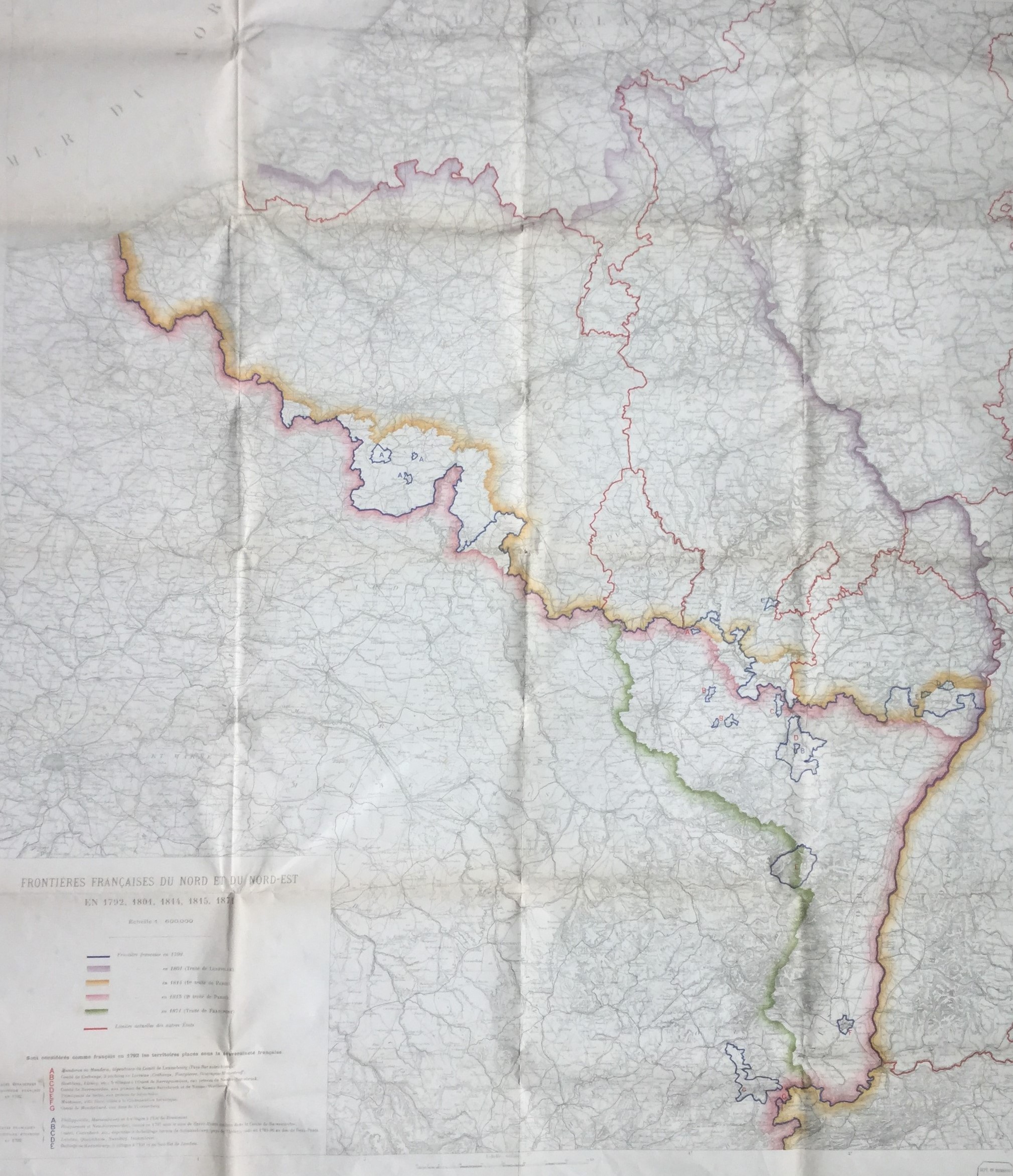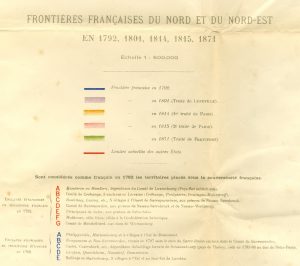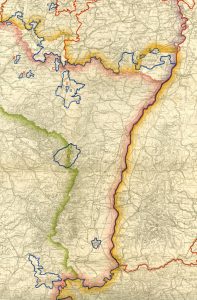
July 2, 2019, by lzzeb
Jeux avec frontières: a map of the historic borders of France prepared for the Paris Peace Conference in 1919
A blog by Professor Mike Heffernan
While preparing for a recent visit to the School’s map collection by members of the Charles Close Society, an unusual map of north-eastern France was uncovered in drawer B109 in a miscellany of war-related material that includes a Napoleonic map of central Europe, several World War One trench maps, and reproductions of aerial photographs of Normandy beaches taken in 1944.
This map, identified during an preliminary visit by Rob Wheeler, the Charles Close Society secretary, is a large format (c. 120 x 90 cm) 1:600,000 sheet entitled ‘Frontières françaises du nord et du nord-est en 1792, 1801, 1814, 1815, 1871’. Using different colours, it shows the changing configuration of France’s north-eastern borders, from the proclamation of the French Republic in 1792 to the aftermath of the Franco-Prussian War, as specified by the treaties of Lunéville (1801), Paris (1814 and 1815) and Frankfurt (1871) (Figs 1-3).

Legend explaining colours used for the frontiers at different dates, and the 1792 enclaves. Please click on image to enlarge.
Although there is no publication date, we know this map was prepared in Paris during the final weeks of World War One and printed shortly after the armistice. It was published as the opening plate in an atlas of vividly coloured thematic maps that accompanied two volumes of reports by the Comité d’Études (CdE), a semi-secret ‘think tank’ established by the French government in January 1917 to develop the country’s war aims.
The CdE was the product of discussions between Raymond Poincaré (the French President), Aristide Briand (who was both Prime Minister and Foreign Minister at the time) and Charles Benoist (a journalist and historian). Its task was to devise intellectual justifications for France’s territorial claims to the ‘lost provinces’ of Alsace-Lorraine ceded to the German Empire in 1871, and for the wider French proposals to dismantle the Austro-Hungarian and Ottoman Empires.
The CdE membership, c. 35 in total, was dominated by historians and geographers, with a small group of linguists and just three economists. Its president, historian Ernest Lavisse, chaired most of the weekly meetings until the committee disbanded in June 1919, shortly before the Treaty of Versailles was signed. The vice-president, until his death in April 1918, was geographer Paul Vidal de la Blache, assisted by secretary and fellow geographer Emmanuel de Martonne. Other geographers involved included Lucien Gallois, Albert Demangeon, Jean Brunhes and Augustin Bernard. Most meetings, some attended by Briand, took place in the Map Library of the Institut de Géographie at the Sorbonne.
The first CdE volume, published in late 1918, opened with six reports by Lavisse, de la Blache and Gallois on Alsace-Lorraine and the country’s northern-eastern frontiers which are fascinating examples of historical geography as a geopolitical project. The ‘frontiers map’ was the principal visual aid for these reports and was designed to reveal France’s ‘natural’ frontiers, agreed at the first Treaty of Paris in 1814. To re-establish this natural order, Alsace-Lorraine should be returned to France, it was argued, without the need for a plebiscite of its population. The returned lands should include the entire Saar coalfield on the grounds that this region had become an integrated industrial zone under German control and could not be divided between two nation-states.
Similar arguments were rehearsed in economic, strategic and ethnographic terms in subsequent reports on Luxembourg, the Rhine as an international river, and the character of ‘les populations rhénanes’, each illustrated with impressive thematic maps. The second CdE volume, published under the misleading title ‘Questions européennes’ as the Peace Conference began, outlined French views on future international borders across Europe and the Middle East, with reference to an even larger quantity of thematic cartography.
Only a few hundred copies of these reports were printed, most of which are now located in French and American research libraries. Only two complete sets of the CdE volumes exist in the UK, in London and Cambridge, so the presence of a single CdE map in Nottingham is mysterious. As this map bears an undated Geography Department stamp, there is no way of knowing when, how or why it was acquired, though it seems plausible that it was purchased during the 1960s by K. C. Edwards who was assembling material on Luxembourg, his abiding regional interest, for an official atlas of the Grand Duchy to mark its centenary as an independent state.
It would be wrong to suggest the CdE had a major influence on the peace negotiations in 1919. Its reports probably confirmed rather than altered the pre-existing geopolitical imagination of French delegates. The impact of these documents on the thousands of politicians, diplomats and intelligence officers from other countries who gathered in Parisian hotels and restaurants a century ago is even less certain.
As artefacts from the history of geography, however, the CdE reports and maps tell another story. They represent the high-water mark of historical geography’s perceived political significance, and demonstrate that liberal European intellectuals still believed that ‘a war to end all war’ could be resolved by punitive territorial exchanges and divisions, regardless of long-term economic considerations. This was the attitude that infuriated John Maynard Keynes who resigned as Treasury representative at the Peace Conference on 5th June 1919, informing Lloyd George that he was ‘slipping away from this scene of nightmare. I can do no more good here’. A few months later, Keynes published The Economic Consequences of the Peace, the first and most devastating critique of the peace negotiations and the geopolitical assumptions on which they were conducted.
References
Comité d’Études (1918-1919) Travaux du Comité d’Études: Tome I – L’Alsace-Lorraine et la frontière du Nord-Est; Tome II – Questions européennes (Paris: Imprimerie nationale)
Dion, R. (1947) Les frontières de la France (Paris: Hachette)
Lowczyk, O. (2010) La fabrique de la paix: du Comité d’Études à la Conférence de la Paix, l’élaboration par la France des traités de la première guerre mondiale (Économica, Paris)
Souton, G.-H. and Davion, I. (eds) (2015) Les experts français et les frontières d’après-guerre: les procès-verbaux du Comité d’Études 1917-1919 (Paris: Bulletin Hors-Série, Société de Géographie)
No comments yet, fill out a comment to be the first


Leave a Reply